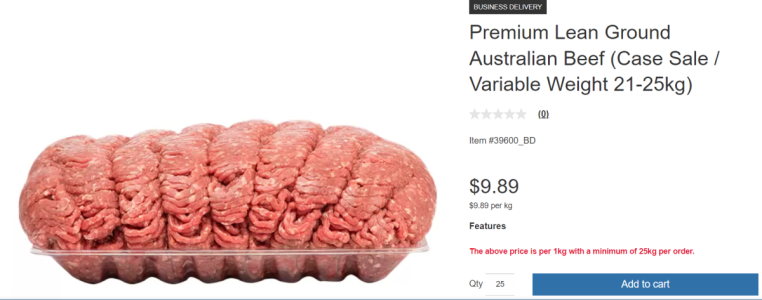Are you missing out on this important detail? Here’s why it pays to take a closer look at pre-packaged foods
Savvy shoppers, listen up! We came across a discovery about pre-packaged foods–and it could mean big savings for you down the track.
One of the things that can sometimes be tricky when it comes to grocery shopping is finding the best prices possible. There are the standard price signs and the flashy sales signs to contend with, but then there are the extra small stickers used on pre-packaged meats and produce.
You should pay the closest attention to these price points, as these–not the overall price of the item–will indicate which is the cheapest product to choose.
For example, a huge package of Costco beef mince looks like a great deal at first glance. It has a reasonable overall price of $47.21, which seems like a no-brainer. However, the details of the sticker can point you in the direction of a better bargain elsewhere.
The pertinent information can be found in the ‘Price per kilo’ section–$9.89.
And what about the ground pork mince at $7.49 per kilo or the lamb loin chops at $19.99 per kilo? These are quite reasonable bargains–if you have a plan for the product once you bring it home, that is.
This means that you’ll need to have the capacity to plan for the product’s usage. This involves meal planning and portioning it out on the day of purchase–but don't worry, your efforts will be rewarded when you take a trip to the checkout.
To compare these prices with other supermarkets. The Costco prices on these products are pretty attractive–though if you shop at Coles or Woolies, you’ll find their prices for the same mince and chops are still relatively competitive.
Coles’ beef mince has a slightly higher price point at $12 per kilo–an extra few dollars more than what you’ll find at Costco–whilst Woolworths’ pork mince sits at $8.75 per kilo, and their lamb loin chops are also only a little bit more expensive at $21 per kilo. Costco’s chicken breast is the closest in price ($10.39 per kilo), but it’s still slightly more expensive than Coles and Woolies’ versions at $11 per kilo.
Here’s the lesson: to save the most money in the long run, you’ll need to actively shop around and pay close attention to the sticker prices–this is the definition of ‘shopping savvy’. That might sound like a lot of work, but it’s ultimately worth it.

If you’re budgeting for a weekly grocery shop for a family of four, for example, those additional savings can add up to quite a bit. That’s why it's worth developing good shopping habits before you checkout.
Did you find this helpful, dear members? What other money-saving tips do you practice in the supermarket? Share them in the comments below!
One of the things that can sometimes be tricky when it comes to grocery shopping is finding the best prices possible. There are the standard price signs and the flashy sales signs to contend with, but then there are the extra small stickers used on pre-packaged meats and produce.
You should pay the closest attention to these price points, as these–not the overall price of the item–will indicate which is the cheapest product to choose.
For example, a huge package of Costco beef mince looks like a great deal at first glance. It has a reasonable overall price of $47.21, which seems like a no-brainer. However, the details of the sticker can point you in the direction of a better bargain elsewhere.
The pertinent information can be found in the ‘Price per kilo’ section–$9.89.
And what about the ground pork mince at $7.49 per kilo or the lamb loin chops at $19.99 per kilo? These are quite reasonable bargains–if you have a plan for the product once you bring it home, that is.
This means that you’ll need to have the capacity to plan for the product’s usage. This involves meal planning and portioning it out on the day of purchase–but don't worry, your efforts will be rewarded when you take a trip to the checkout.
To compare these prices with other supermarkets. The Costco prices on these products are pretty attractive–though if you shop at Coles or Woolies, you’ll find their prices for the same mince and chops are still relatively competitive.
Coles’ beef mince has a slightly higher price point at $12 per kilo–an extra few dollars more than what you’ll find at Costco–whilst Woolworths’ pork mince sits at $8.75 per kilo, and their lamb loin chops are also only a little bit more expensive at $21 per kilo. Costco’s chicken breast is the closest in price ($10.39 per kilo), but it’s still slightly more expensive than Coles and Woolies’ versions at $11 per kilo.
Here’s the lesson: to save the most money in the long run, you’ll need to actively shop around and pay close attention to the sticker prices–this is the definition of ‘shopping savvy’. That might sound like a lot of work, but it’s ultimately worth it.
Key Takeaways
- Customers often miss the critical detail of the per kilo price of pre-packaged supermarket foods.
- Buying pre-packaged goods in bulk can initially appear cheaper, but it is crucial to utilise
these products effectively to avoid waste.
- Costco prices compared well to competitors Coles and Woolworths across a range of pre-packaged meat products.
- Developing good shopping habits and understanding pricing can lead to savings in the long run.
If you’re budgeting for a weekly grocery shop for a family of four, for example, those additional savings can add up to quite a bit. That’s why it's worth developing good shopping habits before you checkout.
Did you find this helpful, dear members? What other money-saving tips do you practice in the supermarket? Share them in the comments below!









